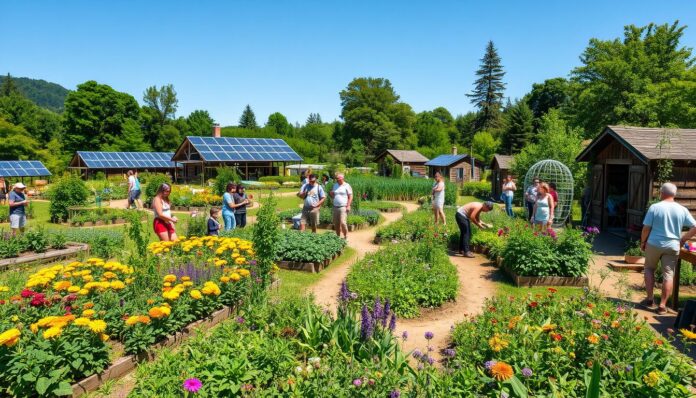As the world moves towards sustainable travel, a key question is: can permaculture tourism really help? Permaculture tourism focuses on caring for the earth, people, and fair sharing. It aims to create a travel experience that is both regenerative and responsible.
With the growth of niche tourism and rural appreciation, permaculture tourism is crucial for rural development. It offers travelers a chance to connect with nature and local communities in a unique way.
Permaculture tourism’s impact is linked to regenerative tourism. This approach aims to increase benefits while focusing on sustainability. By adopting sustainable practices and promoting biodiversity, permaculture tourism helps rural communities and the environment thrive.
The OECD believes tourism will see four major trends by 2040. These include sustainable growth and the use of new technologies. This makes permaculture tourism’s role in shaping travel’s future even more vital.
Key Takeaways
- Permaculture tourism is based on the principles of earth care, people care, and fair share, promoting sustainable travel and eco-friendly tourism.
- The concept of regenerative tourism is closely tied to permaculture tourism, focusing on increasing net benefits and creating a positive impact on the environment and local communities.
- Permaculture tourism can contribute to rural development and the long-term viability of rural communities, offering a unique opportunity for travelers to connect with nature and local cultures.
- The OECD projects that tourism will follow four major development trends by 2040, including sustainable tourism growth and enabling technologies, highlighting the importance of permaculture tourism in shaping the future of travel.
- Permaculture tourism impact can be measured by its ability to promote biodiversity, support local economies, and provide a regenerative and responsible travel experience.
- Sustainable practices and community engagement are essential components of permaculture tourism, ensuring that the benefits of tourism are shared equitably among local stakeholders.
Understanding Permaculture Tourism
Permaculture tourism focuses on traveling in a way that’s good for the planet. It aims to lessen the harm tourism can cause. This method is based on permaculture, which seeks to create systems that are sustainable and self-sufficient.
This type of tourism is different from regular tourism. It emphasizes being green and caring for the environment. It encourages reducing waste, using energy wisely, and saving natural resources. By doing this, permaculture tourism helps make tourism more sustainable.
Definition of Permaculture Tourism
Permaculture tourism combines permaculture’s principles with tourism. It uses clean energy, cuts down on waste, and supports sustainable land use.
Historical Context
The idea of permaculture tourism started in the 1970s. It was a response to environmental worries and the need for living sustainably. Over time, it has grown into a unique tourism that values the environment and social responsibility.
Current Trends
Today, permaculture tourism is getting more popular. It’s embracing practices like rewilding and fixing ecosystems. There’s also a push for tourism that involves local communities more.
Examples of permaculture tourism include using solar and wind power. It also involves managing waste in a sustainable way. These efforts show how permaculture tourism can help the environment and support sustainable growth.
| Initiative | Description |
|---|---|
| Rainwater harvesting | A system for collecting and storing rainwater for non-potable uses |
| Composting toilets | A type of toilet that uses natural processes to decompose human waste |
| Renewable energy sources | Sources of energy that are replenished naturally, such as solar and wind power |
By following permaculture’s principles, tourism can be made more eco-friendly. This approach can lead to positive changes and help create a better future.
Economic Impacts of Permaculture Tourism
Permaculture tourism brings many economic benefits. It creates jobs in local communities and brings in money for permaculture sites. It also supports local businesses, which is key for protecting biodiversity in tourism.
This type of tourism promotes sustainable travel. It focuses on being kind to the environment and lowers the carbon footprint of visitors.
Some of the main economic benefits of permaculture tourism are:
- It creates jobs in local communities, helping to lower unemployment and boost the local economy.
- It generates income for permaculture sites, which can be used to improve sustainable infrastructure and support local businesses.
- It supports local businesses, helping to keep more money in the community and reducing economic leakage in traditional tourism.
By using permaculture principles, destinations can cut down on waste and save natural resources. This makes them more appealing to travelers who care about the environment. Many travelers now look for places that value environmental stewardship and community involvement.
Environmental Benefits of Permaculture Tourism
Permaculture tourism lets travelers connect with nature while supporting eco-friendly tourism. It helps reduce the environmental impact of tourism, aiming for a sustainable future. This approach is part of a larger movement towards regenerative travel, focusing on healing the environment and local communities.
Permaculture tourism boosts biodiversity. It uses design principles to create spaces that support many plants and animals. This enriches the tourist experience and helps protect local ecosystems. For instance, permaculture gardens can increase food diversity by 200% compared to traditional farming. Permaculture principles also cut down water use in wellness sites by up to 50% through rainwater harvesting and greywater systems.
Promotion of Biodiversity
Permaculture tourism sites foster biodiversity by creating diverse habitats. They use permaculture design to build self-sufficient ecosystems. Ways to boost biodiversity include:
- Creating permaculture gardens that support local food systems
- Implementing sustainable land management practices that reduce erosion and promote soil health
- Engaging local communities in conservation efforts and promoting eco-friendly tourism practices
Sustainable Land Management Practices
Sustainable land management is key to reducing tourism’s environmental impact. Permaculture tourism sites use mulching, composting, and renewable energy to lower their carbon footprint. For example, using renewable energy can cut carbon emissions by 70% compared to traditional resorts. These practices help make tourism more sustainable for both people and the planet.
Social and Cultural Impacts
Permaculture tourism has big effects on local communities. It promotes responsible tourism and helps keep local cultures alive. Community-based tourism lets visitors connect with locals, learn their ways, and help their economy grow.
Some key benefits of permaculture tourism are:
- It boosts community identity through cultural exchange
- It supports local economies with sustainable travel
- It offers chances for volunteering and community service, fostering understanding
By choosing responsible tourism, visitors help protect local cultures and support their economy. This way of traveling is key for community-based tourism and sustainable travel. It helps local communities thrive.
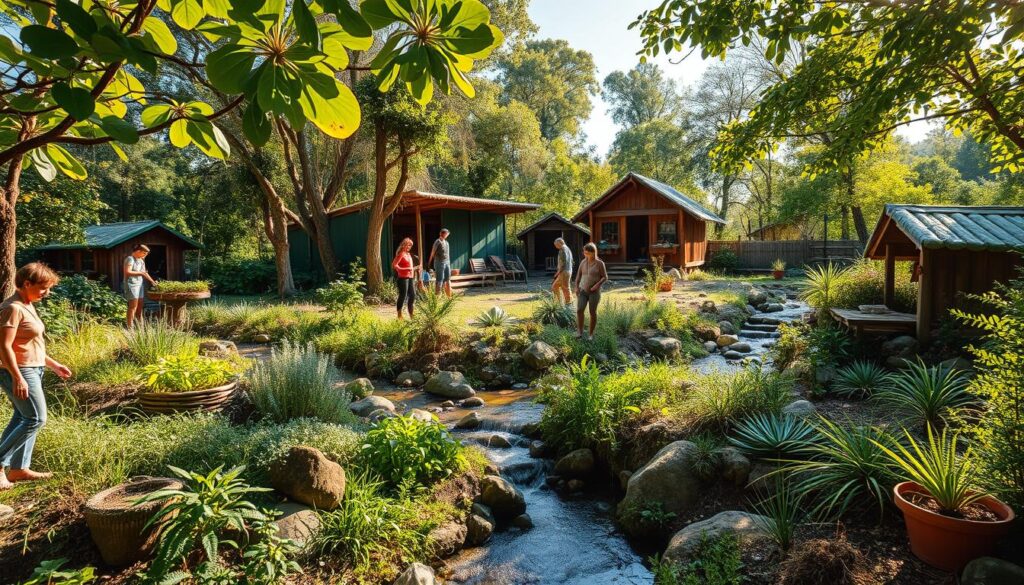
| Benefits | Description |
|---|---|
| Community Engagement | Permaculture tourism promotes community engagement through cultural exchange programs and volunteerism |
| Cultural Preservation | Supports the preservation of local cultures and traditions |
| Economic Development | Contributes to local economic development through sustainable travel practices |
Challenges Faced by Permaculture Tourism
Permaculture tourism, like other tourism types, has its own set of challenges. One big worry is the environmental impact of tourism. This can cause overcrowding and use up resources if not handled right.
To tackle these issues, eco-friendly tourism steps can be taken. This includes cutting down on waste, saving water, and using land in a sustainable way. Also, regenerative travel can be promoted. It aims to make the environment and local communities better.
Some major hurdles for permaculture tourism are:
- Overcrowding and strain on local resources
- Keeping tourism sustainable and protecting the environment
- Meeting visitor expectations while teaching eco-friendly habits
By tackling these problems and pushing for green tourism, permaculture tourism can help the environment and local people. It also gives visitors a special and meaningful experience.
| Challenge | Impact | Solution |
|---|---|---|
| Overcrowding | Strain on local resources | Implement sustainable tourism practices |
| Environmental degradation | Loss of biodiversity | Promote eco-friendly tourism and regenerative travel |
Measuring the Impact of Permaculture Tourism
Permaculture tourism is becoming more popular. People want to travel in a way that’s good for the planet and supports local communities. To see how it’s doing, we need to track its effects on the environment, local people, and the economy. We can use things like energy use, water use, and how much waste is made.
Some good things about permaculture tourism are:
- Soil gets healthier and more food is grown
- Less energy is used and fewer greenhouse gases are made
- More jobs and money for local people
For instance, a permaculture tourism spot in a rural area can help the local economy. It also supports farming that’s good for the planet. By looking at how permaculture tourism affects things, we can see how it helps make the world a better place.
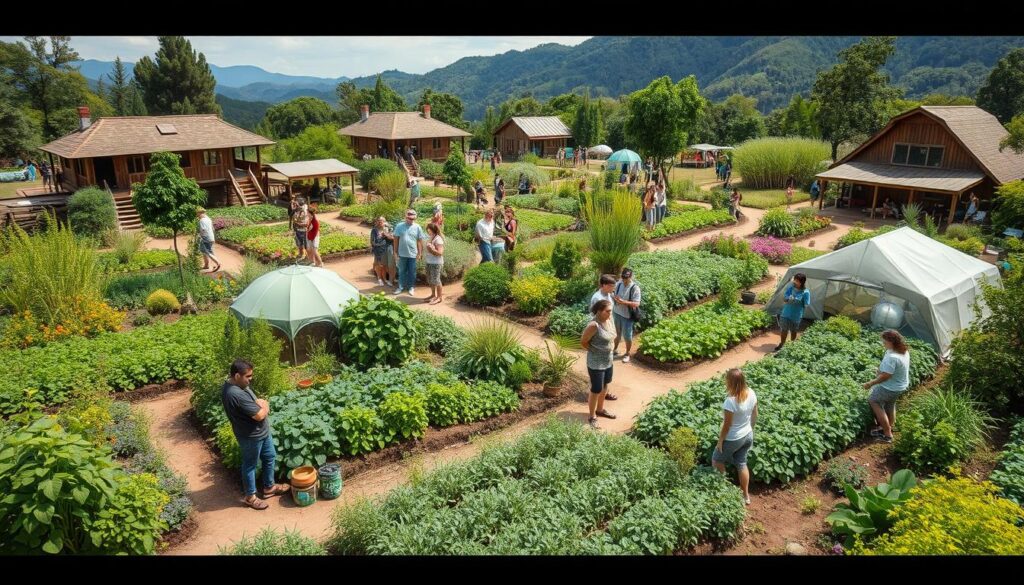
To figure out the impact of permaculture tourism, we can use different ways to gather information. This includes asking people questions, talking to them, and looking at numbers. By looking at the big picture, we can make tourism that’s better for everyone and the planet.
| Indicator | Unit | Target |
|---|---|---|
| Energy consumption | kWh | Reduce by 20% |
| Water usage | Liters | Reduce by 30% |
| Waste reduction | Tons | Reduce by 40% |
Visitor Experience in Permaculture Sites
Permaculture sites offer a unique and immersive experience for visitors. They promote regenerative travel and responsible tourism. Visitors can engage with the local environment and community. This way, they gain a deeper understanding of sustainable living and eco-friendly tourism.
Some key aspects of the visitor experience in permaculture sites include:
- Participation in farm activities and workshops on permaculture and sustainable living
- Immersive learning experiences, such as guided tours and hands-on projects
- Opportunities for feedback and evaluation, to ensure a high level of visitor satisfaction
By focusing on eco-friendly tourism and responsible travel, permaculture sites make a positive impact. They create a positive impact on the environment and local communities. At the same time, they offer a unique and enriching experience for visitors.
| Permaculture Site | Unique Feature |
|---|---|
| Maquenque Eco Lodge | Transitioned from cattle farming to sustainable tourism |
| Rancho Margot | Self-sufficient and carbon-negative lodge with comprehensive permaculture practices |
Strategies for Sustainable Tourism Development
Sustainable travel is key today, with community-based tourism playing a big role. It helps local communities and keeps nature safe. Staying in eco-lodges is a great way to do this. They use green materials and cut down on waste.
Some ways to make tourism better include:
- Getting local communities involved in planning
- Building eco-friendly places like green hotels and green buses
- Teaching tourists to travel responsibly, like using less plastic and respecting local ways
These steps help tourists lessen their harm to the environment and support local businesses. For instance, research shows eco-friendly travelers look for green hotels. This shows there’s a big interest in green travel. Plus, 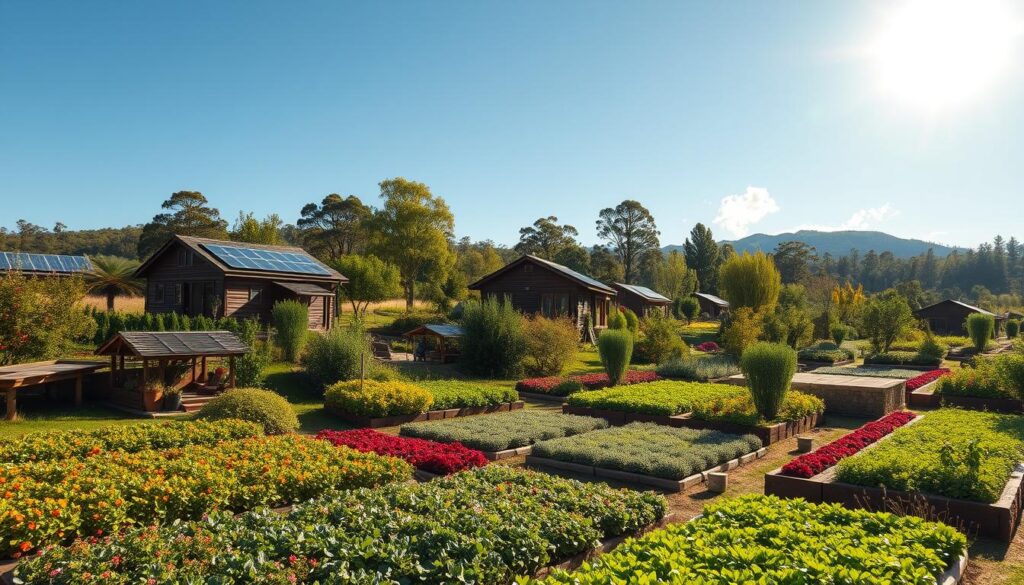
| Strategy | Benefits |
|---|---|
| Community-based tourism | Helps local economies, keeps nature safe |
| Eco-friendly infrastructure | Lessens harm to the environment, supports green growth |
| Responsible travel behavior | Reduces waste, respects local ways, helps keep culture alive |
Together, tourists, local folks, and tourism folks can make travel better. We can focus on saving nature and helping local communities through tourism.
Policy and Regulation Considerations
Policies and regulations are key in promoting responsible tourism. They help reduce the environmental impact of tourism. Governments and regulatory bodies can support regenerative travel by setting rules for sustainable tourism.
Local government policies on tourism include rules on waste, energy, and natural resource conservation. Permaculture, a method for sustainable living, can be part of these policies. It encourages eco-friendly practices and lessens tourism’s environmental harm.
Local Government Policies on Tourism
Local government policies greatly affect the tourism industry. By setting rules for responsible tourism, governments encourage sustainable practices. This helps reduce the environmental impact of tourism.
Permaculture as a Tool for Sustainable Development
Permaculture is a valuable tool for sustainable tourism. It helps tourism operators lessen their environmental impact. This includes organic farming, using renewable energy, and conserving natural resources.
Zoning Laws and Land Use Regulations
Zoning laws and land use regulations are also important. They help promote responsible tourism and reduce environmental harm. By designating areas for tourism and regulating land use, governments can protect natural resources and support sustainable development.
In conclusion, policies and regulations are vital for responsible tourism and reducing environmental harm. By creating rules that support regenerative travel and sustainable development, governments can foster a sustainable tourism industry.
Future Trends in Permaculture Tourism
As the world moves towards eco-friendly tourism and sustainable travel, permaculture tourism is becoming more important. It focuses on regenerative practices, attracting travelers who want regenerative travel experiences.
Recent trends show that permaculture practices are spreading worldwide. They help with sustainable growth and protect the environment. This change comes from more people understanding the value of sustainable travel for local ecosystems.
Some key trends in permaculture tourism include:
- Technological innovations in tourism, enhancing the visitor experience and promoting eco-friendly tourism.
- The rise of eco-conscious travelers, seeking regenerative travel experiences that contribute to environmental conservation.
- Shifts in consumer preferences, with a growing demand for sustainable travel options that support local communities and promote environmental sustainability.
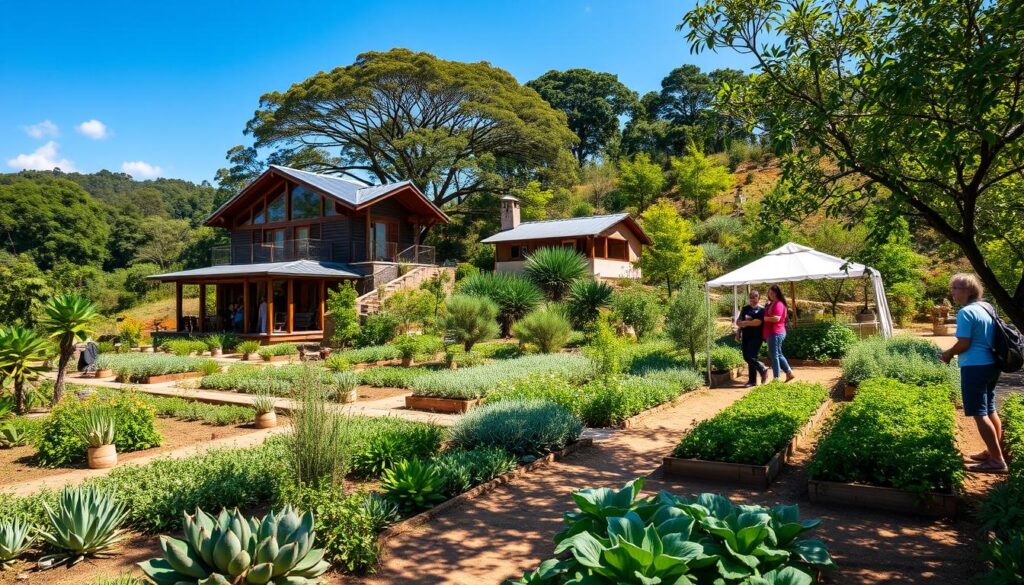
These trends show how permaculture tourism can help with sustainable development and protect the environment. It’s becoming a popular choice for those looking for eco-friendly tourism and regenerative travel experiences.
| Trend | Description |
|---|---|
| Technological Innovations | Enhancing visitor experience through technology |
| Rise of Eco-Conscious Travelers | Seeking regenerative travel experiences |
| Shifts in Consumer Preferences | Demand for sustainable travel options |
Collaborations and Partnerships
Collaborations and partnerships are key in promoting community-based tourism and biodiversity conservation. By teaming up, organizations can make a bigger difference. This helps local communities and the environment.
Some key benefits of working together in tourism include:
- Increased awareness of responsible tourism practices
- Improved conservation efforts
- Enhanced cultural exchange and understanding
- Support for local economies
For instance, TOSCO has been a leader in promoting responsible tourism. They work with local communities and tourism businesses. This has helped make the tourism industry more sustainable and responsible.
As the tourism industry grows, focusing on collaborations and partnerships is crucial. By working together, we can build a sustainable and responsible tourism industry. This benefits both people and the planet.
| Organization | Focus | Impact |
|---|---|---|
| TOSCO | Responsible tourism and community conservation | Improved conservation efforts and support for local economies |
The Role of Education in Permaculture Tourism
Education is key in permaculture tourism. It helps visitors learn about living sustainably. Through workshops and training, people get to try eco-friendly practices like organic farming and renewable energy. This not only boosts their knowledge but also builds a sense of community and cooperation.
Online resources are also vital for sustainable travel and eco-friendly tourism. Websites and blogs on permaculture and sustainable living share lots of useful info. They inspire people to live sustainably, even after their travels.
Workshops and Training Programs
Workshops and training are crucial in permaculture tourism. They teach visitors practical skills and knowledge. From basic organic gardening to advanced permaculture design, these programs help deepen understanding of sustainable practices.
Importance of Skill Development
Skill development is essential in permaculture tourism. It lets individuals use their knowledge in real-world settings. By learning about sustainable agriculture, renewable energy, and eco-friendly construction, visitors can help build sustainable communities.
This, in turn, supports local economies and the environment. It helps eco-friendly tourism grow.
Evaluating Long-term Impacts
As more people seek sustainable travel options, it’s key to look at the long-term effects of permaculture tourism. We need to see how it affects local communities, the environment, and the economy. This helps us find ways to make permaculture tourism better for everyone.
Research shows permaculture tourism can help local communities a lot. It can bring up to 20% more money into local economies than regular tourism. Also, educational programs focused on permaculture can make students more aware of different cultures by 40% on average.
To really understand the long-term effects of permaculture tourism, we must watch changes over time. We need data on things like how many visitors come, how much money is made, and how green it is. This data helps us make better choices and ensure permaculture tourism is done right.
Some permaculture sites are leading the way by reducing their environmental impact. They use washable cotton bags instead of plastic and ceramic containers instead of plastic ones. These actions help the planet and teach visitors about living sustainably.
| Indicator | Baseline | Target |
|---|---|---|
| Visitor numbers | 1000 | 1500 |
| Revenue generated | $100,000 | $150,000 |
| Environmental sustainability | 50% | 80% |
By looking at the long-term effects of permaculture tourism and adopting green practices, we can make it good for both locals and the planet. It also gives visitors a special and educational experience.
Marketing Permaculture Tourism
As more people seek regenerative travel and responsible tourism, marketing permaculture tourism is key. Permaculture sites can draw visitors who want sustainable and green travel. This is by promoting eco-friendly tourism practices.
Studies show that permaculture principles can shape tourism. This makes tourism more sustainable and fair. It also lessens the harm tourism can do to places and people.
Effective Strategies for Promotion
Good ways to promote permaculture tourism include using social media and telling stories. Also, highlight the special experiences and benefits of visiting permaculture sites. This way, permaculture sites can attract those who value regenerative travel and responsible tourism.
Utilizing Social Media
Social media is a strong tool for promoting permaculture tourism. It lets sites share their stories and values with more people. By using social media, permaculture sites can reach out to potential visitors. They can share their green practices and build a community of like-minded travelers.
| Marketing Strategy | Benefits |
|---|---|
| Social Media | Increased visibility, community engagement |
| Storytelling | Emotional connection, unique experiences |
| Eco-Friendly Tourism | Reduced environmental impact, sustainable practices |
Conclusion: The Future of Permaculture Tourism
The world faces big challenges, but permaculture tourism offers hope. It combines travel with community-based tourism and biodiversity conservation. This way, we can make tourism both profitable and good for the environment.
We need everyone to work together for a better future. This includes permaculture experts, tourism businesses, government officials, and travelers who care. We should all support green tourism, protect our planet, and help local communities.
Looking ahead, we must focus on long-term success, not just quick wins. This vision will help us build strong, sustainable communities. Together, we can make a better world for all.

